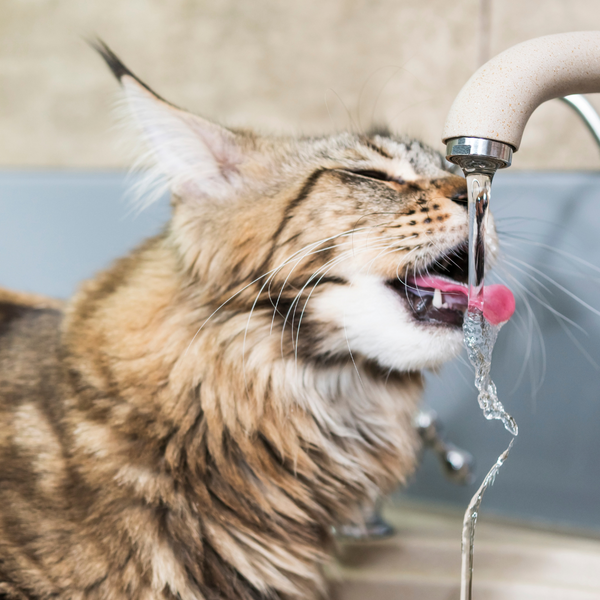
The Dangers of a Dehydrated Cat
(Dr. Iulia Miha, DVM) Dehydration is something every cat owner should be aware of because the onset of dehydration in felines happens quickly and can become dangerous. Dehydration in cats is such a serious medical issue and you should take your cat to the vet immediately if they are exhibiting symptoms. If it is left untreated, dehydration can lead to the death of your pet.
Dehydration is not a disease in itself, but rather a symptom. This can occur if your cat does not drink enough water or if an imbalance has occurred in your pet's body that leads to excessive water loss. The causes of dehydration are varied, the most common being diabetes, fever, heatstroke, kidney disease, diarrhea, and excessive vomiting.
In this article, you will learn why dehydration is so dangerous to felines, how much water a cat needs, what the types of dehydration are, how you can test if your cat is dehydrated, and much more.
What Are the Dangers of Dehydration in Cats?
Cats can become dehydrated at any ambient temperature, not only on hot summer days. As a result, they can reach this state even in the winter because dehydration is related to ambient temperature and your cat’s water intake.
Depending on the cause that led to your cat's dehydration and if the water losses are massive, there are several severe consequences you can expect if you don't intervene in time and take your pet to the vet:
- The general state of your cat will change considerably - they have a poor general state, and sometimes, they end up being unconscious.
- Urination is no longer normal. It can be low or absent.
- Uremia. This azotemic syndrome is caused by the retention of urea in the blood above the normal limit and the presence of other toxic products of protein metabolism - nitrogenous compounds (uric acid, creatine) - which the (diseased) kidney cannot eliminate. In uremia, the affected pet will show symptoms of poisoning (apathy, matted fur, decreased appetite, vomiting, lethargy, weakness, seizures, etc.)
- Low blood pressure (hypotension)
Unfortunately, severe water deficiency can lead to the death of your cat if dehydration is not treated in time.
How Much Water Does My Cat Need?
As mentioned previously, one of the causes of dehydration in cats is insufficient water consumption. A healthy cat on a dry food-only diet should normally consume an average of 45 ml of water per kilogram of body weight (~2 lbs.). Therefore, a four-kilogram cat (~9 lbs.) will consume approximately 240 ml of water per day. Therefore, they need more water per day to properly hydrate because they do not get water from their food.
If your cat often eats wet food, you may notice that they do not drink as much water. There is no need to be alarmed because wet food contains up to 80% water, which is good for your cat.
You also need to consider the following two factors when trying to determine how much water your cat should drink per day: the temperature of the environment and your cat's activity level. Therefore, if it is hot outside or your cat has an intense physical activity, they should consume more water.
What Are the General Clinical Signs of Dehydration in Cats?
Some clinical signs of dehydration in cats may include the following:
- Panting
- Tacky, dry gums
- Refusal of food
- Lack of energy
- Sunken eyes in the sockets
- Skin tenting
Types of Dehydration
Water also contains other important elements for all living organisms found as dissolved trace elements. Sodium, an essential mineral for the body, is retained in the organism by the kidneys while the water is eliminated in the form of urine. Therefore, a disorder of kidney function can lead to a low level of water and electrolytes. As a result, dehydration can be accompanied by a change in the electrolyte balance, and water loss can be divided into three categories:
- Hypertonic dehydration - when the liquid level decreases, that is, when the excretion of water through urine increases, there ends up being much too sodium in the body (water losses exceed sodium losses). Diabetes insipidus is one of the known causes that leads to this type of dehydration.
- Isotonic dehydration – the word "iso" means "equal" and "tonus" means "pressure". Therefore, in this type of dehydration, the water and sodium levels in the cat's body remain balanced. The causes of isotonic dehydration can be diarrhea, vomiting, burns, intrinsic acute kidney disease, or hyperglycemia.
- Hypotonic dehydration – in this type of dehydration, sodium loss is greater than water loss. This can lead to water retention in the tissues (e.g., cerebral edema). Hypotonic dehydration is usually caused by diuretics.
How Can You Test if Your Cat Is Properly Hydrated?
You can easily test if your cat is dehydrated without having to go to the vet. Water is found in all the cells of the body, including the skin. In a dehydrated cat, the skin will fold - it will no longer lie flat as usual because it loses its elasticity. Based on this information, all you have to do is to gently pull the folds on the back of your cat's neck with two fingers and let go at once. I
f your cat is not dehydrated, the folds will return to their original position quickly. If they are dehydrated, the folds will not return to their original position with the same speed. Sometimes in very dehydrated cats, the folds can form a tent-like shape (also called “skin tenting”).
You can also notice if your cat is dehydrated by looking at their eyes. In dehydrated animals, the eyeball retracts into the orbit of the eye. Moreover, in a very dehydrated cat you will also notice some clinical signs.
Tips & Tricks To Prevent Dehydration in Cats
There are some tricks you could apply to prevent your cat from becoming dehydrated.
- Take your cat to the vet regularly to detect potential health problems early – clinically healthy young cats (up to six years old) should be taken to the vet once a year, and adult/older cats twice a year.
- If your cat shows signs of illness, go to the vet for an evaluation, especially if they have diarrhea and/or vomiting (these two can quickly lead to dehydration).
- Give your cat one meal of wet food per day because it has up to 80% water in its composition and will help your pet not to become dehydrated.
- Add chicken broth or tuna juice to your cat's dry food. You can also add these to your cat's water if they refuse to drink water.
- Place several water bowls in the house, especially in the areas where your cat likes to spend the most time.
- Change your cat's water and clean the bowl often.
- Buy a water fountain because cats usually prefer running water.
Conclusion
Unfortunately, severe dehydration in cats can lead to death. Dehydration is not a disease in itself, but rather a symptom. Causes of rapid dehydration in cats include vomiting, diarrhea, and certain diseases (kidney disease, diabetes, thyroid disease). If you see that your cat does not drink much water, is lethargic, does not eat much, and shows other clinical signs, take them to the vet immediately for proper treatment.
If you are not sure if your cat is drinking enough water, you can test by gently pulling the skin on the back of their neck with two fingers and then letting go at once. If the fold does not quickly return to its original position and shape, it means that your cat is dehydrated. To prevent dehydration, you can put several water bowls in the house, change the water and clean the water bowl often, offer wet food, add tuna juice or chicken broth over dry food or in the water, or buy a water fountain.
Dr. Iuliana Mihai, DVM, Masters In Small Animals And Equines Pathology
Iuliana graduated from the University of Agronomical Sciences and Veterinary Medicine in 2012, Romania. She has a Master’s degree in Small Animal and Equines Pathology and a strong affinity for Veterinary Parasitology and Laboratory. In 2013 she started her Ph.D. in epithelial cancer in dogs and cats. She volunteered at the faculty’s clinic in her 3rd year of study, and continued her career in small animal pathology and laboratory. She has one cat and eleven rats. Her interests outside of work include traveling, writing, and crafting.

Post a Comment!